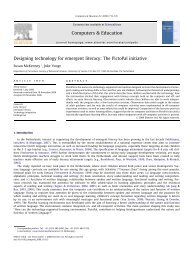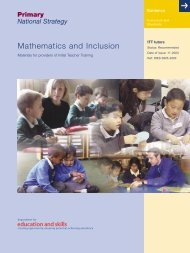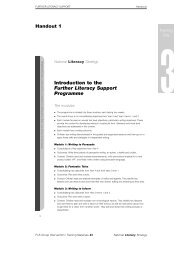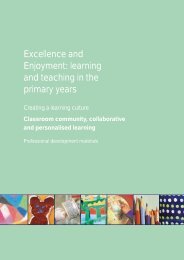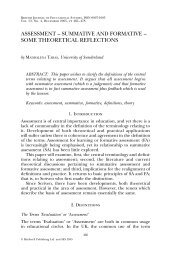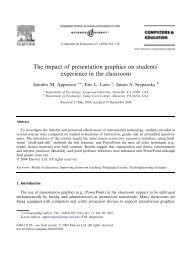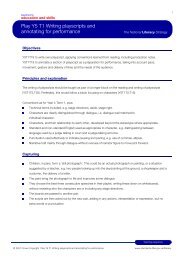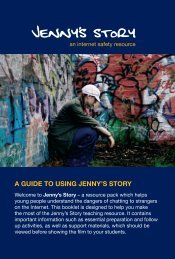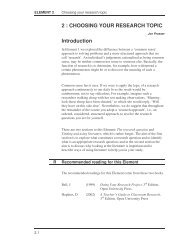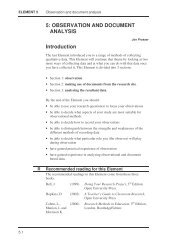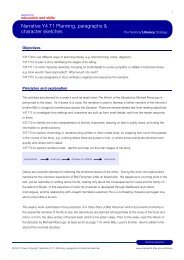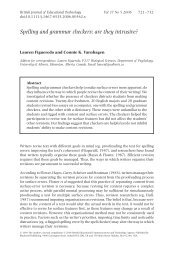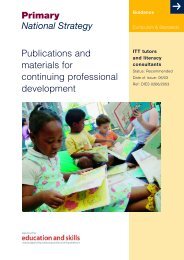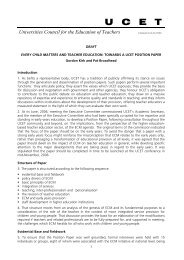A scale for monitoring students' attitudes to learning ... - PGCE
A scale for monitoring students' attitudes to learning ... - PGCE
A scale for monitoring students' attitudes to learning ... - PGCE
You also want an ePaper? Increase the reach of your titles
YUMPU automatically turns print PDFs into web optimized ePapers that Google loves.
Computers & Education 48 (2007) 285–300www.elsevier.com/locate/compeduA <strong>scale</strong> <strong>for</strong> <strong>moni<strong>to</strong>ring</strong> studentsÕ <strong>attitudes</strong> <strong>to</strong> <strong>learning</strong>mathematics with technologyRobyn Pierce a, *, Kaye Stacey b , Anastasios Barkatsas ba University of Ballarat, P.O. Box 663, Ballarat, Vic<strong>to</strong>ria 3353, Australiab University of Melbourne, AustraliaReceived 26 November 2004; accepted 10 January 2005AbstractThe Mathematics and Technology Attitudes Scale (MTAS) is a simple <strong>scale</strong> <strong>for</strong> middle secondary yearsstudents that moni<strong>to</strong>rs five affective variables relevant <strong>to</strong> <strong>learning</strong> mathematics with technology. The sub<strong>scale</strong>smeasure mathematics confidence, confidence with technology, attitude <strong>to</strong> <strong>learning</strong> mathematics withtechnology and two aspects of engagement in <strong>learning</strong> mathematics. The paper presents a model of howtechnology use can enhance mathematics achievement, a review of other instruments and a psychometricanalysis of the MTAS. It also reports the responses of 350 students from 6 schools <strong>to</strong> demonstrate thepower of the MTAS <strong>to</strong> provide useful insights <strong>for</strong> teachers and researchers. ÔAttitude <strong>to</strong> <strong>learning</strong> mathematicswith technologyÕ had a wider range of scores than other variables studied. For boys, this attitude is correlatedonly with confidence in using technology, but <strong>for</strong> girls the only relationship found was a negativecorrelation with mathematics confidence. These differences need <strong>to</strong> be taken in<strong>to</strong> account when planninginstruction.Ó 2005 Elsevier Ltd. All rights reserved.Keywords: Applications in subject areas; Evaluation methodologies; Gender studies; Pedagogical issues; Secondaryeducation* Corresponding author. Tel.: +61 3 53 279283; fax: +61 3 53 279289.E-mail address: r.pierce@ballarat.edu.au (R. Pierce).0360-1315/$ - see front matter Ó 2005 Elsevier Ltd. All rights reserved.doi:10.1016/j.compedu.2005.01.006
286 R. Pierce et al. / Computers & Education 48 (2007) 285–3001. IntroductionTechnology offers enticing possibilities <strong>for</strong> new approaches <strong>to</strong> teaching and hence <strong>for</strong> <strong>learning</strong>across the curriculum. The research and professional literature suggests that the new approachesmay enhance <strong>learning</strong> through cognitive, metacognitive and affective channels. The cognitive andmetacognitive channels <strong>for</strong> improving <strong>learning</strong> by using technology are clearly strong and important<strong>to</strong> study. This paper provides a <strong>to</strong>ol, the Mathematics and Technology Attitudes Scale(MTAS), <strong>to</strong> examine the role of the affective channel, which is also important in improving <strong>learning</strong>,and it reports some results from the use of MTAS in six schools.For <strong>learning</strong> and doing mathematics, technology in the <strong>for</strong>m of Ômathematics analysis <strong>to</strong>olsÕ (suchas certain computer software, calcula<strong>to</strong>rs, graphics calcula<strong>to</strong>rs, computer algebra systems, spreadsheets,statistics programs) can assist studentsÕ problem solving, support exploration of mathematicalconcepts, provide dynamically linked representations of ideas and can encourage generalmetacognitive abilities such as planning and checking. In addition, in<strong>for</strong>mation technology in the<strong>for</strong>m of Ôreal world interfacesÕ such as digital cameras, video cameras and data loggers can bring<strong>to</strong> life in the classroom those outside situations <strong>to</strong> which mathematics is applied (see, <strong>for</strong> example,Oldknow, 2003). With substantial investment in providing in<strong>for</strong>mation technology <strong>to</strong> assist inteaching and <strong>learning</strong> mathematics, it is important <strong>to</strong> moni<strong>to</strong>r studentsÕ reactions and decide howbest <strong>to</strong> use both <strong>for</strong>ms of technology, the mathematics analysis <strong>to</strong>ols and the real world interfaces.Reports of almost any major teaching innovation of the last 25 years include data on studentsÕ<strong>attitudes</strong> <strong>to</strong> the innovation as well as their mathematical achievement. McLeod (1992), who providesa careful analysis of previous research on affect in mathematics education, is adamant thataffective issues play a central role in mathematics <strong>learning</strong> and that Ômathematics education researchcan be strengthened if researchers integrate affective issues in<strong>to</strong> studies of cognition andinstructionÕ (p. 575). The literature published since 1992 also affirms that affective fac<strong>to</strong>rs and beliefsimpact on student <strong>learning</strong>: in general positive <strong>attitudes</strong> and beliefs and intrinsic motivation are reflectedin increased ef<strong>for</strong>t in <strong>learning</strong> and greater persistence. Ruffell, Mason, and Allen (1998) areconcerned that <strong>attitudes</strong> may not be sufficiently well defined conceptually or sufficiently stable <strong>to</strong> bereliable but ‘‘influenced by social and emotional context and personal construction of theseÕ (p. 15).We would agree with Ruffell et al. that <strong>attitudes</strong> can ÔflipÕ from negative <strong>to</strong> positive and in particularthat Ôgood teachingÕ can have such an effect, but we disagree that this means that <strong>moni<strong>to</strong>ring</strong> attitudewill not prove fruitful <strong>for</strong> mathematics education research. Since <strong>attitudes</strong> can be affected byrecent experience, a series of experiences promoting positive or negative attitude can indeed contribute<strong>to</strong> the development of more persistent <strong>attitudes</strong> and even beliefs which are deeply heldand strongly influence future behaviour. Attitudes are commonly distinguished from beliefs in that<strong>attitudes</strong> are moderate in duration, intensity and stability and have an emotional content, while beliefsbecome stable and are not easily changed (Mayes, 1998; McLeod, 1992; Pajares, 1992). In thispaper, we do not make a strict distinction between <strong>attitudes</strong> and beliefs, but use the terms ÔattitudeÕand ÔaffectiveÕ <strong>to</strong> encompass both feelings and opinions about doing and <strong>learning</strong> mathematics.1.1. The hypothesized modelThis paper reports the development of a <strong>scale</strong> <strong>to</strong> moni<strong>to</strong>r affective changes which result fromtechnology use and which are likely <strong>to</strong> have an impact on improving <strong>learning</strong>. Fig. 1 outlines a
R. Pierce et al. / Computers & Education 48 (2007) 285–300 287Fig. 1. Illustration of hypothesized affective channel <strong>for</strong> technology use <strong>to</strong> improve mathematics <strong>learning</strong>. (Variablesmeasured in MTAS in heavily outlined boxes: MC, TC, AE, BE, MT).hypothesized model. The main row of boxes across the centre of Fig. 1 shows that we hypothesizethat in<strong>for</strong>mation technology in the classroom can enable more real world problem solving. Both<strong>for</strong>ms of technology, the mathematics analysis <strong>to</strong>ols and the real world interfaces, contribute.More real problem solving, making mathematics more relevant <strong>to</strong> studentsÕ lives and more interesting,is in turn hypothesized <strong>to</strong> lead <strong>to</strong> increased Ôaffective engagementÕ (defined below). Use ofmathematics is, in addition, hypothesized <strong>to</strong> lead <strong>to</strong> increased confidence in doing mathematicsbecause these can take some of the computational burden from students. These effects combine<strong>to</strong> improve studentsÕ behavioural engagement (defined below) during lessons and hence improve<strong>learning</strong>. Confidence in using technology (extreme left side box) is seen as predisposing students <strong>to</strong>full participation in lessons using technology, along with a number of unspecified fac<strong>to</strong>rs (e.g.,having suitable equipment and a teacher willing and able <strong>to</strong> use it). Similarly, both <strong>for</strong>ms of technologyhave cognitive and metacognitive effects (elongated <strong>to</strong>p and bot<strong>to</strong>m boxes) which will impac<strong>to</strong>n <strong>learning</strong> but are not of concern here. On the bot<strong>to</strong>m right hand side, a positive attitude <strong>to</strong>using technology <strong>to</strong> learn mathematics is shown as an outcome of improved <strong>learning</strong>. However, afavourable attitude also provides a feedback loop, making further effective use of technology <strong>for</strong><strong>learning</strong> likely. Evidence <strong>for</strong> this is provided from the multiple case studies reported by Pierce andStacey (2004). This paper aims <strong>to</strong> provide a simple instrument which can be used <strong>to</strong> explorewhether these links are evident in practice, although there is no attempt in this paper <strong>to</strong> fully testthe model.This study is linked <strong>to</strong> the RITEMATHS project (HREF1), which is conducting a series of curriculumdesign experiments <strong>for</strong> middle secondary school teaching of mathematics. Based on thebroad experience of the teaching and research team and relevant literature, we plan <strong>to</strong> make strategicuse of technology <strong>to</strong> facilitate the use of real world problems in mathematics classes, aiming
288 R. Pierce et al. / Computers & Education 48 (2007) 285–300<strong>to</strong> increase studentsÕ engagement and confidence and thereby increase achievement as shown inFig. 1. Consequently, we wish <strong>to</strong> track changes in the <strong>attitudes</strong> and engagement of students intheir <strong>learning</strong> of mathematics, in response <strong>to</strong> the altered <strong>learning</strong> environment and <strong>to</strong> considerhow best this use of technology can be implemented. The five heavily outlined boxes in Fig. 1show the constructs measured by the MTAS, all of which are relevant <strong>to</strong> our proposed RITE-MATHS curriculum changes.In a curriculum design experiment like the RITEMATHS project, it is important <strong>to</strong> moni<strong>to</strong>rstudent <strong>attitudes</strong> throughout the project. The malleable nature of <strong>attitudes</strong> means that it maybe possible <strong>to</strong> create repeated episodes engendering positive <strong>attitudes</strong> and so, in time, contribute<strong>to</strong> these students establishing positive stable beliefs and behaviours <strong>for</strong> their mathematics <strong>learning</strong>.The need <strong>to</strong> assess studentsÕ attitudinal response be<strong>for</strong>e and after each teaching experimentprompts the requirement <strong>for</strong> a minimally intrusive method of collecting data. For this reason asimple questionnaire approach was chosen as the primary source of data. This will, of coursebe Ôself-reportÕ data and any claims of changes over time will need <strong>to</strong> be confirmed by classroomobservation, and teacher and student interviews.For our study we want sub<strong>scale</strong>s which allow us <strong>to</strong> moni<strong>to</strong>r the five variables highlighted in Fig. 1:mathematics confidence (MC), affective engagement (AE), behavioural engagement (BE), confidencein using technology (TC) and attitude <strong>to</strong> the use of technology <strong>to</strong> learn mathematics(MT). The rest of this paper discusses some of the available <strong>scale</strong>s, our choices of items, andthe psychometric analysis of the resulting MTAS, which is given in Appendix A. We thendemonstrate the power of MTAS <strong>to</strong> provide useful insights <strong>for</strong> teachers, by reporting on differencesbetween schools and between genders. We will begin by considering relevant literatureand establishing the need <strong>for</strong> a new <strong>scale</strong> <strong>for</strong> ongoing <strong>moni<strong>to</strong>ring</strong> of students.2. The need <strong>for</strong> another <strong>scale</strong>Attitudes have been studied in various ways, with data collected from individual interviews,focus groups, diaries, observation and questionnaires. Since the research of Fennema andSherman in the 1970s, questionnaires have become standard <strong>to</strong>ols <strong>for</strong> assessing student <strong>attitudes</strong>,especially when <strong>attitudes</strong> alone are not the focus of the study but rather viewed asone fac<strong>to</strong>r <strong>to</strong> be moni<strong>to</strong>red when assessing the likely success of a curriculum or teaching innovation.The literature does not support one approach over another. In every case the act ofasking questions will prompt thoughts in the mind of some students which they may not haveotherwise had and they will feel obliged <strong>to</strong> answer. Asking students <strong>to</strong> pause and reflect brieflyin order <strong>to</strong> respond <strong>to</strong> a questionnaire may there<strong>for</strong>e provide data which would not be obviousthrough observation and would take <strong>to</strong>o much time <strong>to</strong> collect by interviewing everystudent.We need an instrument that is suitable <strong>for</strong> students as young as fourteen, with widely varyingscholastic abilities. Since the project will moni<strong>to</strong>r curriculum innovations, the instrument will need<strong>to</strong> be administered regularly without taking <strong>to</strong>o much class time. Some well known instrumentsare <strong>to</strong>o long and complex <strong>for</strong> our purpose. For example, the classic Fennema and Sherman(1976) <strong>scale</strong>, which measures some constructs of interest <strong>to</strong> us, has 108 items and according <strong>to</strong>Tapia and Marsh (2004) one needed <strong>to</strong> allow students up <strong>to</strong> 45 min. Scales also become dated.
R. Pierce et al. / Computers & Education 48 (2007) 285–300 289Shades of meaning of words change and, while older <strong>scale</strong>s provide most helpful models, newitems need <strong>to</strong> be constructed which will be immediately unders<strong>to</strong>od by the current student cohort.Other recent research in our Australian context provides resources on which a suitable <strong>scale</strong> maybe built. For example, Galbraith and Haines (1998) provide a contemporary resource but theirsubjects were tertiary students and their focus, related <strong>to</strong> particular courses, meant that items werenot immediately transferable <strong>to</strong> our study. Similarly, Fogarty, Cretchley, Harman, Eller<strong>to</strong>n, andKonki (2001) validated a questionnaire <strong>to</strong> measure tertiary studentsÕ mathematics confidence,computer confidence and <strong>attitudes</strong> <strong>to</strong>wards the use of technology <strong>for</strong> <strong>learning</strong> mathematics. Their<strong>scale</strong>, focused on just these three constructs, has 37 items including a number of long statements,making it unsuitable <strong>for</strong> direct transfer <strong>to</strong> our setting. Chapman (2003), on the other hand, produceda validated <strong>scale</strong> <strong>for</strong> use with primary aged students. Her ÔHow I feel About MathsÕ <strong>scale</strong>focuses mainly on the construct we will describe below as Ôaffective engagementÕ. The items in this<strong>scale</strong> provide exemplars of brief, simply worded statements which each address one idea but the<strong>scale</strong> does not cover the breath of <strong>attitudes</strong> we consider important <strong>for</strong> our study. Vale and Leder(2004) report a study of the relationship between gender and <strong>attitudes</strong> <strong>to</strong> using computers <strong>for</strong><strong>learning</strong> mathematics using a questionnaire as one source of data. While their <strong>scale</strong> is targetedat the same age range as our study (early/middle secondary years), and the issue of gender mayemerge as an important variable, we want <strong>to</strong> look more broadly. The Vale and Leder <strong>scale</strong> had11 items <strong>for</strong> Ôattitude <strong>to</strong> computer-based mathematicsÕ and only one item <strong>for</strong> each of four othervariables.While acknowledging the advantage of building on previous research without modification,none of the available <strong>scale</strong>s was deemed suitable <strong>for</strong> repeated <strong>moni<strong>to</strong>ring</strong> of studentsÕ <strong>attitudes</strong>in a diversity of middle secondary years classes. However the <strong>scale</strong> we have constructed has manyideas and some items in common with other published <strong>scale</strong>s. We have minimised the number ofitems and constructed short statements. In addition, we have avoided the use of negatively wordeditems, <strong>for</strong> two reasons. First, we want students <strong>to</strong> be able <strong>to</strong> complete the questionnaire quicklyand accurately and negative items often cause some hesitation or incorrect responses due <strong>to</strong> thelogic of double negatives etc. Second, since a student may complete this questionnaire many timesover three years, we do not want <strong>to</strong> seed negative thinking. While negatively worded items arecommonly included in order <strong>to</strong> address possible acquiescence in response <strong>to</strong> items this was notconsidered <strong>to</strong> be a major problem with our participants, who operate within a school culturewhere they feel their opinions are valued and criticism (implied or direct) of authorities iscommon.3. Key concepts consideredDefining the composition of <strong>attitudes</strong> is not simple. In the literature referenced in this paperthere is general agreement that confidence and engagement are important but certainly not preciseagreement as <strong>to</strong> their measurable features. StudentsÕ vocabulary and behaviour indicating confidenceand engagement will be dependent on local culture and context, age and stage. These fac<strong>to</strong>rsneed <strong>to</strong> be taken in <strong>to</strong> consideration in wording the statements <strong>to</strong> which we ask students <strong>to</strong>respond. The section which follows includes the items we constructed, the meaning we have assigned<strong>to</strong> each construct and where that fits in relation <strong>to</strong> definitions used in other recent studies.
290 R. Pierce et al. / Computers & Education 48 (2007) 285–3003.1. Mathematics confidenceVale and Leder (2004) view studentsÕ <strong>attitudes</strong> <strong>to</strong> mathematics as being defined by the studentsÕperceptions of their achievement (self-efficacy) and their aspiration <strong>to</strong> achieve in the disciplines.Galbraith and Haines (1998) see mathematics confidence as evidenced by students Ôwho believethey obtain value <strong>for</strong> ef<strong>for</strong>t, do not worry about <strong>learning</strong> hard <strong>to</strong>pics, expect <strong>to</strong> get good results,and feel good about mathematics as a subjectÕ (p. 278).We have restricted our meaning of the term Ômathematics confidenceÕ <strong>to</strong> a studentÕs perceptionof their ability <strong>to</strong> attain good results and their assurance that they can handle difficulties in mathematics.The studentsÕ views are canvassed directly through five brief items shown in Table 1. Theitem numbers include the letter p (<strong>for</strong> preliminary) <strong>to</strong> indicate it is the numbering of items in thepreliminary questionnaire, rather than the final MTAS, which is given in Appendix A. Since wewish <strong>to</strong> moni<strong>to</strong>r change over time rather than take a single snap shot of student <strong>attitudes</strong>, we haveframed items that seek their immediate reactions rather than asking students either <strong>to</strong> reflect onthe past or consider their aspirations <strong>for</strong> the future. We have decided that whether or not studentsÔfeel good about mathematicsÕ (as in Galbraith and HainesÕ construct above) is sufficiently important<strong>to</strong> be separated from confidence and is considered under Ôaffective engagementÕ.3.2. Confidence with technologyIn this construct, Vale and Leder (2004) follow Forgasz (1995) in viewing studentsÕ <strong>attitudes</strong><strong>to</strong> technology (in their case computers) as being defined by the studentsÕ perceptions of theirachievement (self-efficacy) and their aspiration <strong>to</strong> achieve in these disciplines. This parallelsthe components of their construct of mathematics confidence. Galbraith and Haines (1998) takea different view, seeing technology confidence (again in their case this is computer confidence) asevidenced by students who Ôfeel self-assured in operating computers, believe they can mastercomputer procedures required of them, are more sure of their answers when supported by acomputer, and in cases of mistakes in computer work are confident of resolving the problemthemselvesÕ (p. 278). The meaning we have assigned <strong>to</strong> this construct closely matches that ofGalbraith and Haines and differs from Vale and Leder. Table 2 lists the items we chose. Withinthe time of this project it is anticipated that many of the students involved will use a variety oftechnology in their mathematics classes. For this reason we included item 2p which canvassestheir confidence <strong>to</strong> use a broad range of commonly available technology. This also pointed<strong>to</strong> the construct of confidence with technology relating <strong>to</strong> life outside as well as inside theclassroom.Table 1Items in preliminary questionnaire assessing mathematics confidence (MC)Item numberStatement <strong>for</strong> response (given five-point <strong>scale</strong>)5pI have a mathematical mind11pI can get good results in mathematics12pI know I can handle difficulties in mathematics16pI am confident with mathematics18pI have less trouble <strong>learning</strong> mathematics than other subjects
R. Pierce et al. / Computers & Education 48 (2007) 285–300 291Table 2Items in preliminary questionnaire assessing confidence with technology (TC)Item numberStatement <strong>for</strong> response (given five-point <strong>scale</strong>)1pI am good at using computers2pI am good at using things like VCRs, DVDs, MP3s and mobile phones3pI can fix a lot of computer problems4pI would be more confident of my school work with a computer <strong>to</strong> help me19pI can master any computer programs needed <strong>for</strong> school3.3. Attitude <strong>to</strong>wards use of technology <strong>for</strong> <strong>learning</strong> mathematicsVale and Leder (2004) measured Ôattitude <strong>to</strong> computer-based mathematicsÕ with 11 items, definingit as Ôthe degree <strong>to</strong> which students perceive that the use of computers in mathematics providesrelevance <strong>for</strong> mathematics, aids their <strong>learning</strong> of mathematics and contributes <strong>to</strong> their achievementin mathematicsÕ (p. 291). Galbraith and Haines (1998) define a similar construct which theycall Ôcomputer and mathematics interactionÕ. They claim that in their context ÔStudents indicatinghigh computer and mathematics interaction believe that computers enhance mathematical <strong>learning</strong>by the provision of many examples, find note-making helpful <strong>to</strong> augment screen based in<strong>for</strong>mation,undertake a review soon after each computer session, and find computers helpful inlinking algebraic and geometric ideasÕ (p. 279).In this case, our construct is closer <strong>to</strong> that of Vale and Leder (2004) than Galbraith and Haines(1998). We have focused broadly on interest and assistance <strong>to</strong> <strong>learning</strong> without expecting the moresophisticated and specific reflections which Galbraith and Haines sought from tertiary students.In this quick survey we do not expect 14 and 15-year-old students <strong>to</strong> analyse the ways in whichtechnology contributes <strong>to</strong> their <strong>learning</strong> of mathematics. If and when this level of detail may behelpful, we will use interviews which allow <strong>for</strong> clarification of both questions and the studentsÕresponses. While the simple items we constructed, shown in Table 3, use the term Ôgraphics calcula<strong>to</strong>rÕother versions of this questionnaire replace this term with ÔcomputerÕ or Ôcomputer algebrasystemÕ, depending on the mathematics used by the specific group of students surveyed. Onlyitems related <strong>to</strong> this construct are varied in this way.3.4. Affective and behavioural engagementNext we consider the two aspects of engagement. Fredricks, Blumenfeld, and Paris (2004) providea comprehensive overview of literature relating <strong>to</strong> school engagement in general. They seeTable 3Items in preliminary questionnaire assessing attitude <strong>to</strong>wards use of technology <strong>for</strong> <strong>learning</strong> mathematics (MT)Item numberStatement <strong>for</strong> response (given five-point <strong>scale</strong>)8pI like using graphics calcula<strong>to</strong>rs <strong>for</strong> mathematics9pI learn more when I use graphics calcula<strong>to</strong>rs in mathematics14pUsing graphics calcula<strong>to</strong>rs in mathematics is worth the extra ef<strong>for</strong>t15pMathematics is more interesting when using graphics calcula<strong>to</strong>rs20pGraphics calcula<strong>to</strong>rs help me learn mathematics betterGraphics calcula<strong>to</strong>r version; replace with computer or other technology as appropriate.
294 R. Pierce et al. / Computers & Education 48 (2007) 285–300Attitudes Scale (MTAS) and it is included as Appendix A. Users of the MTAS can easily obtaineach sub<strong>scale</strong> score by adding the responses <strong>to</strong> the four items. Students can complete it within 10min.After the initial fac<strong>to</strong>r analysis and reliability analysis, seven items were deleted from the set.Omitting items 4p, 18p and 21p from the TC, MC and BE sets led <strong>to</strong> increased CronbachÕs alphain the respective sub<strong>scale</strong>s. In the MT subset, item 9p correlated highly with items 8p, 15p and 20pand was there<strong>for</strong>e redundant and hence could be omitted. In the initial fac<strong>to</strong>r analysis, item 13p(‘‘Mathematics is boring’’) linked more closely with MC than with its intended AE. Item 13p wasalso the only negatively worded item and as such was open <strong>to</strong> coding error by future users. It wasthere<strong>for</strong>e omitted. While there was no strong positive or negative statistical consequence of thechoice of the two further items <strong>to</strong> delete from the BE subset, items 26p and 27p focus on deeperaspects of <strong>learning</strong> style and cognitive engagement than other items, and are there<strong>for</strong>e omitted.Fac<strong>to</strong>r analysis and reliability analysis were then re-applied <strong>to</strong> the resulting 20-item MTAS.Statistical analysis using data from 350 complete studentsÕ responses <strong>to</strong> the 20 items <strong>for</strong>ming theMTAS indicates that this data satisfies the underlying assumptions of Principal ComponentsAnalysis and that <strong>to</strong>gether five fac<strong>to</strong>rs (each with eigenvalue greater than 1) explain 65% of thevariance, with almost 26% attributed <strong>to</strong> the first fac<strong>to</strong>r, MC. Reliability analysis yields satisfac<strong>to</strong>ryCronbachÕs alpha values <strong>for</strong> each sub<strong>scale</strong> (MC, .87; MT, .89; TC, .79; BE, .72 and AE, .65). Thisindicates a strong or acceptable degree of internal consistency in each sub<strong>scale</strong>.6. Using the MTAS <strong>to</strong> explore school and gender variationMTAS sub<strong>scale</strong> scores can be calculated by simple addition of responses. With a maximumpossible score on any sub<strong>scale</strong> of 20 and a minimum of 4, we consider scores of 17 or above <strong>to</strong>be high, indicating a very positive attitude, 13–16 <strong>to</strong> be moderately high and 12 or below <strong>to</strong> bea low score reflecting a neutral or negative attitude <strong>to</strong> that fac<strong>to</strong>r.6.1. Variation of MTAS scores amongst schoolsIn this section we report on the responses of different schools on the MTAS variables (20 itemsonly), again from the sample of 350 students. Fig. 2 gives the box plots <strong>for</strong> all sub<strong>scale</strong>s, and then,<strong>for</strong> each of the schools, on each MTAS subscore. The number of students responding at eachschool varies from 16 (School F) <strong>to</strong> 152 (School C) with an average of 59 students per school.The boxplots <strong>for</strong> the school results show no obvious links between the five sub<strong>scale</strong>s. Scores onthree of the sub<strong>scale</strong>s (affective engagement AE, behavioural engagement BE and confidence withtechnology TC) have similar medians at all schools, and students have generally high or moderatelyhigh scores. Whilst the high scores <strong>for</strong> the self-reported behavioural engagement might beexpected, it is good <strong>to</strong> see that only in one school (E) did more than 25% of students score lessthan 12 in affective engagement (AE) (i.e., lower average than the neutral response), and in allof the schools at least 75% of students scored more than 12 on confidence with technology(TC). Given the uni<strong>for</strong>m means on the first three sub<strong>scale</strong>s, it is interesting <strong>to</strong> observe the variationbetween schools in mathematics confidence (MC) and attitude <strong>to</strong> <strong>learning</strong> mathematics withtechnology (MT).
296 R. Pierce et al. / Computers & Education 48 (2007) 285–300The scores on MT are the most interesting <strong>for</strong> this paper. At four schools, some students gavethe maximum possible score. At two schools, some students gave the minimum possible score.StudentsÕ opinions on <strong>learning</strong> mathematics with technology are there<strong>for</strong>e divided, even withinschools. We might discount the results from School C because at the time of the survey, these studentshad little experience of <strong>learning</strong> mathematics with technology. However, we cannot discountthe results from School B, where technology use is well established in mathematics classes. At thetime of the survey, School E had just finished their first experience of using graphics calcula<strong>to</strong>rs inmathematics: this good experience may explain the high scores, although the long tail is also presen<strong>to</strong>nce again indicating that there is considerable variability in studentsÕ evaluations of <strong>learning</strong>mathematics with technology. Some of this variability may be due <strong>to</strong> consistent differences betweenboys and girls. For example, in their study of a small sample of students of a similar ageand similar location <strong>to</strong> the present study, Vale and Leder (2004) found that boys view computer-basedmathematics lessons more favourably than girls. Gender differences are there<strong>for</strong>eexamined in the next section.6.2. Gender differencesGender differences in <strong>attitudes</strong> <strong>to</strong> mathematics have long been of interest (Fennema & Sherman,1976, is an early study), and a question of current interest is whether using technology <strong>to</strong>learn mathematics exacerbates differences. This section there<strong>for</strong>e reports results on the five sub<strong>scale</strong>sby gender. In order <strong>to</strong> remove between-school influences from the data, only the responsesfrom the four co-educational schools are considered in this section. This means that the boys andgirls in the sample have experienced the same <strong>learning</strong> environments. One hundred and <strong>for</strong>ty-one(70 boys and 71 girls) completed all items although more students (152 <strong>to</strong>tal) completed all itemsof some sub<strong>scale</strong>s.The breakdown of these scores by gender, illustrated in Fig. 3, reveals that boys have statisticallysignificantly higher scores than girls <strong>for</strong> each sub<strong>scale</strong> except BE (t = .005, df = 151,p = .996). The differences are greatest <strong>for</strong> TC (t = 6.84, df = 152, p = .000) and MC (t = 6.13,df = 155, p = .000) with MT (t = 2.85, df = 149, p = .005) and AE (t = 2.56, df = 152, p = .011)demonstrating less difference. While 50% of boys score 16+ on MC, this was true <strong>for</strong> only 25%of girls. TC scores are even more strongly higher <strong>for</strong> boys, with approximately 75% of boys scoring16+ and only 25% of the girls. These results reflect the common finding that boys expressgreater confidence than girls, but they contrast with those of Vale and Leder (2004) who foundgender differences only on their variable corresponding <strong>to</strong> MT. It is important <strong>to</strong> note that notall the students with negative <strong>attitudes</strong> <strong>to</strong> <strong>learning</strong> mathematics with technology are girls. The distributionsof MT have a long tail <strong>for</strong> both boys and girls and high inter-quartile ranges (the highest<strong>for</strong> the boysÕ scores). The high variability in MT is there<strong>for</strong>e not explained by genderdifferences: we need <strong>to</strong> look beyond <strong>learning</strong> environment and gender <strong>to</strong> explain the range of studentsÕevaluations of the effectiveness of <strong>learning</strong> with technology.Table 6 presents the correlations between the sub<strong>scale</strong> scores <strong>for</strong> the 141 students from theco-ed schools, and also <strong>for</strong> males and females separately. There are statistically significant positivecorrelations (weak or moderate) between all pairs of AE, BE, MC and TC. The correlationsbetween AE, BE and MC may be explained by their common concern with school mathematics.The correlations with TC are perhaps surprising, but may possibly be explained by a home
R. Pierce et al. / Computers & Education 48 (2007) 285–300 2972016Sub<strong>scale</strong> score12AEBE8TCMT4MCN =7070 70 70 70 71 71 71 71MaleFemale71GenderFig. 3. MTAS scores <strong>for</strong> sub<strong>scale</strong>s by gender.Table 6Correlations <strong>for</strong> males and females between MTAS sub<strong>scale</strong> scoresBE TC MT MCAE Combined .471 ** .308 ** .021 .549 **Male .307 ** .266 * .171 .605 **Female .506 ** .284 ** .082 .529 **BE Combined .240 ** .012 .452 **Male 1 .289 * .131 .271 *Female – .217 ** .047 .492 **TC Combined .240 ** .509 **Male 1 .358 ** .489 **Female – .064 .427 **MT Combined .033Male 1 .116Female – .223 *** Correlation is significant at the .05 level (2-tailed).Correlation is significant at the .01 level (2-tailed).background fac<strong>to</strong>r, linking inclination <strong>to</strong> school mathematics with technical interests and equipmentin the home.The variable MT is, with two exceptions, not significantly correlated with the others. However,it is correlated positively with TC <strong>for</strong> boys and negatively with MC <strong>for</strong> girls. The positive correlation<strong>for</strong> boys is consistent with the findings of Vale and Leder (2004), although as notedabove, their measure of ‘‘computing achievement’’ is somewhat different. The significant negative
298 R. Pierce et al. / Computers & Education 48 (2007) 285–300correlation <strong>for</strong> girls with mathematics confidence is in the opposite direction <strong>to</strong> the (non-significant)correlation found in the Vale and Leder study. We have two explanations <strong>for</strong> its negativedirection. It may be that there is a weak tendency <strong>for</strong> those girls whose confidence is based on theirself-perception that they can learn <strong>to</strong> follow rules diligently, not <strong>to</strong> value technology <strong>for</strong> <strong>learning</strong>mathematics because it may take over from them this same accurate per<strong>for</strong>mance of routine procedures.An alternative explanation is that there is a weak tendency <strong>for</strong> girls who do not feel confidentabout mathematics <strong>to</strong> value using technology <strong>for</strong> <strong>learning</strong> mathematics more. Both of thesesituations have been reported in case study data by Pierce and Stacey (2004). The data availabledoes not provide conclusive evidence <strong>to</strong> decide which, if either, of the two explanations appliesmore frequently and hence might cause the negative correlation. However, examination of thescattergram <strong>for</strong> MT and MC <strong>for</strong> girls demonstrates that the group of low confidence girls generallyvalue technology <strong>for</strong> <strong>learning</strong>, lending support <strong>to</strong> the second explanation. However the scattergramalso shows that the most confident group of girls exhibit a range of valuing of technology,which may be due <strong>to</strong> different reactions from girls whose high confidence is differently based;which is consistent with the first explanation. These explanations there<strong>for</strong>e warrant further investigation.Whereas boys may experience <strong>learning</strong> mathematics more positively simply becausetechnology is present, some girls may value it when they feel it has the potential <strong>to</strong> compensate<strong>for</strong> self-perceived shortcomings.In interpreting all the gender differences, it is important <strong>to</strong> note that only a few girls actuallyexpressed negative responses (<strong>to</strong>tal score less than 12) <strong>to</strong> any of the fac<strong>to</strong>rs. It is not that the girlsÕscores are very low, rather that there was a more highly positive response from the boys.In every school, most students agreed rather than disagreed that it was better <strong>to</strong> learn mathematicswith technology. These results suggest that this <strong>scale</strong> is proving <strong>to</strong> be suitable <strong>for</strong> discriminatingdifferences between cohorts of students and hopefully <strong>for</strong> indicating change over time withrepeated administration.7. ConclusionThis paper outlines the rationale <strong>for</strong>, construction, analysis and application of a simple <strong>scale</strong> <strong>for</strong>assessing studentsÕ <strong>attitudes</strong> <strong>to</strong> mathematics, technology and the <strong>learning</strong> of mathematics withtechnology. The Mathematics and Technology Attitudes Scale (MTAS) questionnaire consistsof only 20 short items and can be administered in less than 10 min. The analysis is simple, sincethe scores on the items are simply added <strong>to</strong> get the sub<strong>scale</strong> scores. Modification of the last fouritems tailors the <strong>scale</strong> <strong>for</strong> students who regularly use computers, graphics calcula<strong>to</strong>rs or othermathematics. If desired, the MT items can be repeated in different versions <strong>to</strong> measure <strong>attitudes</strong><strong>to</strong> <strong>learning</strong> with another technology. They are placed last on the <strong>scale</strong> <strong>to</strong> make this easier.Administering the <strong>scale</strong> <strong>to</strong> students in 6 schools provided in<strong>for</strong>mation about differences betweenschools and genders, and also gave some clues as <strong>to</strong> what variables contribute and do not contribute<strong>to</strong> studentsÕ evaluation of the effectiveness of <strong>learning</strong> mathematics with technology. As wework through the potential opportunities offered by technology <strong>for</strong> enhancing the teaching and<strong>learning</strong> of mathematics it is important that all aspects are moni<strong>to</strong>red. This <strong>scale</strong> provides aninstrument that can be used in classrooms by either teachers or researchers interested in triallingteaching innovations which include the use of new technology.
R. Pierce et al. / Computers & Education 48 (2007) 285–300 299AcknowledgementsThe authors thank the teachers and students of the RITEMATHS project <strong>for</strong> generouslygiving their time <strong>to</strong> supply data <strong>for</strong> this study. The project is funded by the AustralianResearch Council, with Chief Investiga<strong>to</strong>rs Kaye Stacey, Gloria Stillman and RobynPierce.Appendix A. Mathematics and Technology Attitudes Scale(Final version showing the usually invisible sub<strong>scale</strong> membership of items)FIVE SUBSCALES: mathematics confidence [MC], confidence with technology [TC], attitude<strong>to</strong> <strong>learning</strong> mathematics with technology [MT], affective engagement [AE] and behaviouralengagement [BE]. To tailor MT items <strong>to</strong> a particular class, change the words ‘‘graphics calcula<strong>to</strong>rs’’<strong>to</strong> the technology used by that class (e.g., computers, graphics calcula<strong>to</strong>rs, computer algebrasystems). Do not change TC items.HardlyEverOccasionallyAbout Halfthe timeUsuallyNearlyAlways1. I concentrate hard in mathematics [BE] HE Oc Ha U NA2. I try <strong>to</strong> answer questions the teacher asks HE Oc Ha U NA[BE]3. If I make mistakes, I work until I have HE Oc Ha U NAcorrected them. [BE]4. If I canÕt do a problem, I keep trying HE Oc Ha U NAdifferent ideas. [BE]StronglydisagreeDisagree Not sure Agree Stronglyagree5. I am good at using computers [TC] SD D NS A SA6. I am good at using things like VCRs, SD D NS A SADVDs, MP3s and mobile phones [TC]7. I can fix a lot of computer problems [TC] SD D NS A SA8. I can master any computer program SD D NS A SAneeded <strong>for</strong> school [TC]9. I have a mathematical mind [MC] SD D NS A SA10. I can get good results in mathematics SD D NS A SA[MC]11. I know I can handle difficulties in SD D NS A SAmathematics [MC]12. I am confident with mathematics [MC] SD D NS A SA13. I am interested <strong>to</strong> learn new things in SD D NS A SAmathematics [AE]14. In mathematics you get rewards <strong>for</strong> your SD D NS A SAef<strong>for</strong>t [AE]15. Learning mathematics is enjoyable [AE] SD D NS A SA16. I get a sense of satisfaction when I solve SD D NS A SAmathematics problems [AE](continued on next page)
300 R. Pierce et al. / Computers & Education 48 (2007) 285–300Appendix A (continued)17. I like using graphics calcula<strong>to</strong>rs <strong>for</strong>mathematics [MTg]18. Using graphics calcula<strong>to</strong>rs inmathematics is worth the extra ef<strong>for</strong>t[MTg]19. Mathematics is more interesting whenusing graphics calcula<strong>to</strong>rs. [MTg]20. Graphics calcula<strong>to</strong>rs help me learnmathematics better [MTg]StronglydisagreeDisagree Not sure Agree StronglyagreeSD D NS A SASD D NS A SASD D NS A SASD D NS A SAReferencesChapman, E. (2003). Development and validation of a brief mathematics attitude <strong>scale</strong> <strong>for</strong> primary-aged students.Journal of Educational Enquiry, 4(2), 63–73.Fennema, E., & Sherman, J. (1976). Fennema–Sherman Mathematics Attitudes Scales. Instruments designed <strong>to</strong>measure <strong>attitudes</strong> <strong>to</strong>ward the <strong>learning</strong> of mathematics by females and males. Abstracted in the JSAS Catalog ofSelected Documents in Psychology, 6(1), 31 (Ms No. 1225).Fogarty, G., Cretchley, P., Harman, C., Eller<strong>to</strong>n, N., & Konki, N. (2001). Validation of a questionnaire <strong>to</strong> measuremathematics confidence, computer confidence, and <strong>attitudes</strong> <strong>to</strong>wards the use of technology <strong>for</strong> <strong>learning</strong>mathematics. Mathematics Education Research Journal, 13, 154–160.Forgasz, H. (1995). Gender and the relationship between affective beliefs and perceptions in grade 7 mathematicsclassroom <strong>learning</strong> environments. Educational Studies in Mathematics, 28, 219–239.Fredricks, J., Blumenfeld, P., & Paris, A. (2004). School engagement: potential of the concept, state of the evidence.Review of Educational Research, 74(1), 59–109.Galbraith, P., & Haines, C. (1998). Disentangling the nexus: <strong>attitudes</strong> <strong>to</strong> mathematics and technology in a computer<strong>learning</strong> environment. Educational Studies in Mathematics, 36, 275–290.HREF1 RITEMATHS project. (2004). Available from: www.extranet.edfac.unimelb.edu.au/DSME/RITEMATHS.University of Melbourne. Accessed 26 November.Mayes, R. (1998). ACT in algebra: student attitude and belief. International Journal of Computer Algebra inMathematics Education, 5(1), 3–13.McLeod, D. B. (1992). Research on affect in mathematics education: a reconceptualisation. In D. A. Grouws (Ed.),Handbook of research on mathematics teaching and <strong>learning</strong> (pp. 575–596). New York: MacMillan.Oldknow, A. (2003). Mathematics from still and video images. Micromath. Summer, 2003, 30–34.Pajares, M. F. (1992). TeachersÕ beliefs and educational research: cleaning up a messy construct. Review of EducationalResearch, 62(3), 307–322.Pierce, R., & Stacey, K. (2004). A framework <strong>for</strong> <strong>moni<strong>to</strong>ring</strong> progress and planning teaching <strong>to</strong>ward the effective use ofcomputer algebra systems. International Journal of Computers <strong>for</strong> Mathematical Learning, 9(1), 59–93.Ruffell, M., Mason, J., & Allen, B. (1998). Studying attitude in mathematics. Educational Studies in Mathematics, 35,1–18.Tapia, M., & Marsh II, G. (2004). An instrument <strong>to</strong> measure mathematics <strong>attitudes</strong>. Academic Exchange Quarterly,8(2), 1–8.Vale, C., & Leder, G. (2004). Student views of computer-based mathematics in the middle years: does gender make adifference? Educational Studies in Mathematics, 56, 287–312.



